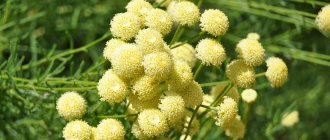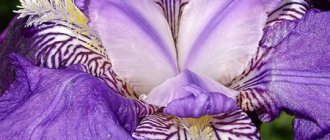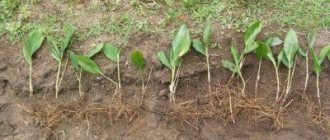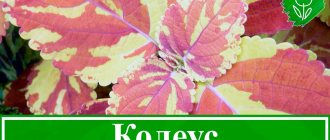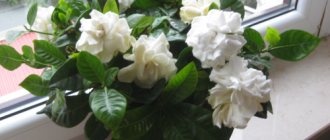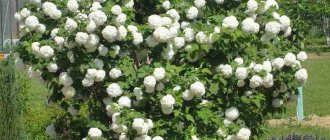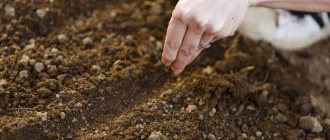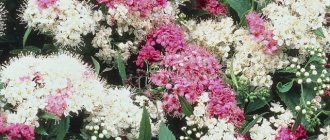What is sedum and what does it look like?
Sedum (also known as sedum) is a plant from the large Crassulaceae family. Herbaceous succulent. Most species are perennial, but there are biennials and annuals.
Sedums decorate the yard at any time of the year
Why is it called that?
The Latin name Sedum comes from the word “sedare”, which means “to pacify”. The second version is derived from sedere, “to sit,” since the plant is close to the ground. The Russian name comes from the Ukrainian “cleaning” - what is used to cleanse wounds.
For your information! Common names for sedum are hare cabbage, spurge, fever grass, and also squeaky grass.
External characteristics
Types of sedum are varied. It can be herbaceous, semi-shrub, or shrubby. Prefers dry soil of mountain slopes and meadows.
A succulent is distinguished by its leaves. They have a fleshy structure, no petioles, and branched stems. Depending on the composition of the water, soil, and the abundance of sun, the leaves may turn red or acquire reddish-pink streaks and veins.
Medicinal properties
The plant contains many valuable substances. These are alkaloids and flavonoids, coumarins, tannins and other medicinal substances.
Tinctures, decoctions, and extracts are prepared from it. They are used as a tonic, diuretic, laxative, analgesic, and treat inflammation. Sedum preparations are used to get rid of burns, scurvy, nervous ailments, gout and atherosclerosis.
Important! Caustic sedum is the only species that is best not to be used as a medicine. It is poisonous and requires great care.
Description
Sedum is a perennial or biennial succulent. Its varieties are heat-loving, winter-hardy, and ground cover. Dense shoots branch, forming shrubs and subshrubs, many species are ampelous. Leaves without petioles, fleshy, oval, sometimes flat, swollen. They are located opposite each other.
Different varieties have different leaf colors - green, pink, gray, with reddish streaks. Bright sun, shade, wind, and soil composition also affect the color of sedum. The root system is represented by tubers.
The umbrella-shaped inflorescences bloom in summer or autumn. Their color is scarlet, blue, pink, white, yellow. The dense and bent petals form a narrow tube, from which the stamens are visible. The flowers smell pleasant and attract bees and bumblebees. Many varieties are poisonous.
Due to the content of alkaloids, tannins, glycosides, flavonoids, organic acids, vitamin C, the plant has medicinal properties. Its parts tone, cleanse the skin, help against heart disease, and painkillers are prepared from the leaves.
Ground cover (creeping) sedums and their varieties
Tree peony - description of the species, the best varieties for the garden
Ground cover sedums create a kind of carpet on the ground, spreading across the soil itself. They are also called lodging.
Sedum Anacampseros
Recently separated into another genus - sedum, but among the people it remained a sedum.
It is distinguished by round, thin leaves that are brownish in spring and green in summer. The stems grow 30 cm in length. It blooms from June, the small flowers are purple, and the inflorescences are loose and round. Loves light and calcareous soil, does not tolerate drought, needs watering.
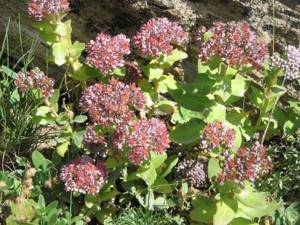
Sedum Anacampseros is not bright, but stable
Sedum cornflower
It grows in bushes. The leaves are bluish thick with red specks. Blooms in late summer, flowers are bright pink. Prefers moist, warm soil.
Hybrid sedum
The stems are creeping, the leaves are thin green, and the flowers are light yellow. The inflorescences of hybrid sedum are rare and appear at the end of summer.
Note! Used in floristry.
Sedum foliage
Evergreen variety. The stems are creeping, and the leaves are thick, collected in dense groups. The height of the plant is average, no more than 20 cm. The color of the leaves is rich green or bluish, the flowers are pastel pinkish.
Sedum Siebold
A variety with green leaves of medium thickness. In home gardens, they often decorate alpine slides. Peduncles rise above the main stems; Siebold's flowers are yellow.
Important! Sedum Siebold blooms actively in October.
Sedum Kamchatka
Forms low bushes about 25 cm. The leaves are usually green, but turn red when there is plenty of light. Kamchatka sedum has yellow and orange flowers, after which small scarlet fruits remain. The flowering period is from mid-summer to September.
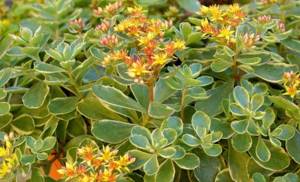
Sedum Kamchatka flowers look harmonious on rocky surfaces
Sedum Kuril
Perennial with oblong thin leaves. The height of the stem is up to 10 cm. The leaves are rich green in color, the flowers are yellow, and produce red fruits. Blooms throughout the warm season.
Sedum lanceolate
Its height is no more than 12 cm. The foliage is gray or bluish, but the plant turns red if it receives a lot of light. The flowers are always yellow and appear from the beginning of June.
Sedum false (Spurium)
The leaves are ovate, forming dense rosettes. Their color is green, sometimes reddish. Bright crimson inflorescences rise above the creeping stems. False sedum blooms all summer. It is resistant to frost. Popular with landscape designers.
Note! An interesting variety is the Voodoo sedum with red-brown leaves forming rosettes.

Mysterious Voodoo Sedum
Sedum spatulafolia
The height of the stems is about 10 cm, the leaves are thick, slightly curved. The color is bluish, on top they seem to be covered with a silvery-white coating. The flowers are yellow and bloom from May.
Sedum multistem
The stems grow 7-10 cm, the leaves are thick green, and the small flowers are pink. Does not welcome waterlogged soil and cold. Blooms at the end of summer.
Bird's sedum
The leaves are small, but thick, densely covering the stem. Usually green, but if there is a lot of sun, they turn red. For this reason, bird sedum is red in summer. The height of the bush is 7-10 cm. Sensitive to the composition of the soil.
Note! It blooms in clayey areas because it does not like excess nutrition.
Sedum divergent
This is a small bush, up to 5-6 cm. The leaves are green and also turn red in the light, but not completely. The color of the flowers is yellow, the inflorescences are modest. Sedums of this variety are resistant to cold, but cannot tolerate excess moisture in the ground.
Sedum Selskogo
Tall appearance, rises 20 or 40 cm. Leaves of medium thickness are green, lemon flowers with a green tint. Sedum Selskogo blooms in late summer. Often used in landscape design.
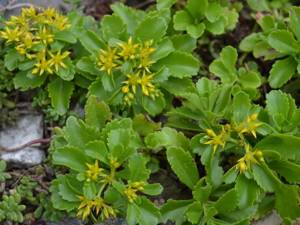
Sedum Selskogo - a noticeable and unpretentious variety
Sedum Takeshima
It grows with creeping shoots, the length of which is 20-40 cm. The leaves are thin, light green in color, collected in rosettes, crowned with yellow inflorescences. Blooms in July.
Important! In warm climates it is green all year round.
Sedum thicket
Low-growing sedum, only up to 5 cm. The leaves are succulent turquoise or green-blue. Their beauty compensates for the bluish-pink inconspicuous flowers. Flowering period is May-October.
Forster's sedum
It looks like a bent sedum. The shoots are creeping, up to 10 cm high, growing in curls. The color of the leaves is greyish, turning red towards the end of summer. There is a variety with blue foliage - Elegans. It blooms until late autumn, but there are few flowers.
Sedum Ellacombe
The height of the plant is medium, the leaves are thick, needle-shaped and green in color. It blooms all summer, the flowers are bright yellow, followed by orange fruits.
The best varieties of tall sedums
Perennial foxglove - the best types and varieties for the garden
Shrub species can grow 70 cm or more. They grow in any soil and do not require complex care, so they are often planted in garden plots.
Common sedum (or Sedum Telephium)
He's a hare cabbage. The stems are fleshy and smooth, the height of the bush is 25-50 cm. The leaves are thin, oblong, dark or light green. By winter the stems die off and grow again in the spring.
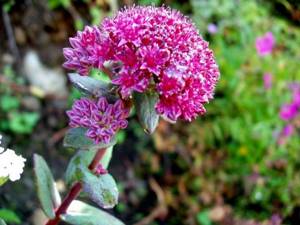
Sedum Telefium adds sophistication to the flowerbed
For your information! Sedum flowers are different: purple, red or pink, crimson.
Sedum redspot
Grows in bushes 30-60 cm in height. The leaves are glaucous, white at the edges. The flowers are white. Flowering period is autumn.
Sedum tenacious
Stems are brown with a noticeable scarlet tint, straight, green foliage is thin. Bright yellow flowers decorate the garden from June to September. The height of the bush is up to 35 cm. It is not for nothing that this sedum is called tenacious; it is one of the hardiest of its kind.
Sedum prominent
Has many varieties:
- Matron;
- Stardust;
- Purple Emperor;
- Diamond;
- Frosty Morn;
- Iceberg;
- Sunsparkler, etc.
Sedums Matrona, Purple Emperor, Sunsparkler are especially common in Russian gardens.
Sedum prominent is a plant up to 80 cm tall with succulent leaves of light green, emerald or red color. Blooms throughout the warm season.
Popular unpretentious types of sedums
Sedum - planting and care, reproduction
Hardy, undemanding to soil and light, but not inferior in beauty to other species and varieties.
Caustic sedum
Or Sedum acre. This is a low bush with strong, fleshy stems with succulent ovate leaves. Bright yellow flowers appear in June, but fade by August.

Acrid sedum is attractive, but dangerous
The description of sedum says that it is a valuable honey plant.
Important! The juice of this sedum can burn and damage the skin and other tissues.
Popular varieties:
- Aureum, or bent (Aureum);
- Yellow Queen (Yellow Queen);
- Elegance.
Morgana sedum
Latin Morganianum. An unusual, showy sedum with trailing stems and thick grape-like leaves that fall off easily. Their color is grayish or green, light, even whitish. The flowers are pink with conspicuous yellow stamens. The beauty of Morgana sedum makes it a popular home decoration.
Popular varieties: Burrito, compact, Sedeveria Harry Butterfield.
Adolf's sedum
Shrub sedum with fleshy wide leaves. The young plant is green, the old one becomes yellow or pink. The flowers of Sedum Adolf are white.
Sedum white
The leaves of sedum are white and medium green in thickness. It blooms from the 15th of July until the end of summer with white flowers. The height of the stems ranges from 5-15 cm.
Known varieties:
- Faro Form;
- Coral Carpet;
- Murale.
Sedum pale yellow
The stems are squat, the leaves have a slight bluish tint. It can rise 15 cm above the ground, and the peduncles are much higher, up to 30 cm. The flowers are yellow and bloom in July-August.
Spanish sedum
Grows in a mat 5-10 cm in height. Leaves may be pale green or pinkish. This sedum is also yellow. The flowers are white or pink. Blooms actively in mid-summer.
Important! Spanish sedum loves timely watering.
Sedum Middendorf
The leaves and stems are characteristically green with a reddish tint. The flowers are yellow with an orange center. If there is support, it rises 25-30 cm.

Sedum Middendorf can grow quite large
Varieties of Middendorf's sedum - Striatum, Diffusum.
Sedum bent (rocky)
They are classified as perennial sedums. A herbaceous variety that is medium in height. The leaves are thin, long, greenish-yellow in color, sometimes with a blue or crimson tint. The flowers of sedum are yellow and bloom from June to July.
For your information! In some countries, sedum reflexum is eaten.
Sedum
Grows in low bushes with long peduncles. The leaves are bluish, dark, the flowers are yellow. It is necessary to provide adequate lighting; it survives drought.
Sedum trifoliate
Low, 7-15 cm, bush with green flat leaves. Grows in a dense carpet. The flowers are white, look like stars, and bloom in May.
Sedum narrow-petalled
Low, up to 20 cm, sedum. The leaves are green or reddish of medium thickness, the flowers are scarlet.
Loves bright light and tolerates low temperatures well.
Sedum hexagonal
Low-growing sedum, only 5-7 cm tall, peduncles - 10-15 cm. The leaves are green in color, arranged scattered on the stem, spirally. Flowering period is mid-summer. The flowers are yellow.
Sedum Eversa
The stems of the plant are straight and long. The round, thick leaves are colored bluish, have a red tint at the edges, and are covered with a whitish coating. The flowers are pink and small.
Note! Evers' sedum is not afraid of frost, but it does not tolerate heavy watering.
Rare species of sedum
These plants are not widespread, but deserve attention.
Sedum graceful
It forms a low mat, its height is only 3-4 cm. The leaves are small but thick, their color is green, and the buds are pale pink. It blooms from early to mid-summer and successfully survives winter.
Sedum pampiniform
A shade-tolerant sedum that grows up to 10 cm. The stems and leaves are green, but gradually turn red in bright sun. The flowers are colored rich yellow. Grows in bushes without creating a hard carpet.

Sedum pampiniforms can be mistaken for a weed, but this is far from true
Sedum runnerum
It forms a cover on the ground, above which flower stalks rise (20 cm). The leaves are pale green, the flowers are light lilac or pink. The shoots branch. Flowering continues from June to August.
Other types of rare sedums:
- Lydian;
- Alberta;
- poplar;
- Tatarinova;
- Troll.
Popular varieties
Each variety of sedum has its own twist and is in demand among gardeners. However, there are varieties that have been popular for more than 5 years.
Sedum Kamchatka
A loose bush consisting of erect shoots 30-35 cm high. The length of the dark green elongated leaves is 4-5 cm. The edges at the base of the plate are smooth, and on the opposite - jagged. Yellow flowers up to 2 cm in diameter form dense inflorescences. The size of one umbrella is 11-13 cm. It enters the flowering phase in June and emerges after 2-3 weeks.
Sedum caramel Kamchatka
A perennial plant with vertical stems 20 cm high. The ellipsoid leaves have a blunt edge near the petiole and a toothed edge at the apex. Small flowers are orange-yellow. Corymbose inflorescences form in June and decorate the plants for 25-30 days.
Sedum purple carpet
A perennial herbaceous plant, which was discovered by the German botanist M. Bieberstein in the 19th century. The succulent is a compact bush 15-20 cm high and 40-50 cm in diameter. Densely leafy stems spread along the ground. Bright green oblong leaves are arranged in two rows.
The length of the plate is 5-6 cm, width - 3-4 cm. The flowers are red with pointed petals. Purple sedum blooms for 1.5-2 months, starting in the first half of summer. Succulent Sedum purpurea is grown from seeds according to the same principle as all succulents.
Sedum Eversa
Compact perennial shrub. By the beginning of autumn, the red-brown shoots become woody. The round, small leaves are bluish-gray and thick. Flowers, painted pink, are collected in inflorescences. The flowering period begins in July and lasts about two months. In autumn the plant sheds its leaves.
Sedum is beautiful
Perennial with creeping stems. The leaf blades are thick, turgorous, and bluish. Prefers to grow in soil made from leaf and turf soil, sand (1:1:2). Grow in low pots.

Types and varieties of heat-loving sedums
They love the sun, but do not winter well, so they are suitable for southern regions or indoor keeping.
Sedum lineara
The stems are lodging, branching, take root easily, reach 30-40 cm. The leaves are green, whitish or emerald, growing in 3 pieces. (whorled).
For your information! The flowers are yellow, but they are very rarely seen.
Sedum Makina
It grows like a low mat and almost never rises above the ground. The leaves are rich green, the flowers are bluish, but so small that they are almost invisible. Tolerates a long absence of moisture and is not sensitive to the composition of the soil.
Sedum polychaete
Sedum with burgundy-brown stems and thickened, needle-like leaves. It grows on average 10-12 cm, blooms actively, peaks at the end of summer. The flowers are inconspicuous.
Not only does it cope poorly with cold, but also with excess moisture.
Oregon sedum
One of the most striking types of sedums. The stems and leaves are fleshy green or dark red. It blooms profusely from the middle of the summer season, the flowers are large yellow-orange.
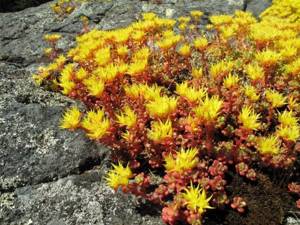
Oregon sedum - solar flare in the garden
Sedum syzofolia
The height of its stems is up to 10 cm, the leaves are dense, greenish-gray and of medium thickness. The flowers are white with dark speckled stamens and bloom in June.
The sedum is pretty
This sedum is an annual flower. Grows in bushes 10-15 cm tall. The leaves are thick, juicy green with a pinkish tint. The flowers are pink or white. Flowering period - late summer - early autumn.
Sedum care
Sedums tolerate bright sun and aridity well, accumulating water in their fleshy leaves, but excess moisture and shade, on the contrary, cause them to rot and die. Plants are unusually resistant to pests and various diseases. Sedums should not be fed or fertilized - this can lead to plant diseases and disturbances in growth and shape (excessively long shoots, huge inflorescences that are difficult to hold and fall apart with little wind, etc.).
It is advisable to support tall types of sedums with supports so that the bushes maintain their integrity, do not become disordered and empty spaces do not form. Plants can be pruned either in the fall (after the onset of frost, when the inflorescences acquire a brownish tint), leaving a small above-soil layer, or in the spring, when the first green leaves appear.
It is recommended to rejuvenate sedums every two to three years. To do this, several young small specimens are separated from large bushes and planted in a new place.
Sedum propagation can be done by seeds, root or leaf layering (vegetatively) or simply by dividing the bush into separate shoots. Dividing a bush is the simplest method of propagation; new shoots quickly take root in light sandy soil. It is best to plant sedums in the spring.
Breeding decorative sedums
You can propagate any sedum in three ways:
- seeds;
- shoots;
- dividing the bush.
Propagation by seeds
Seed material is taken from dried fruits. They are planted in pots (clay or ceramic) in late autumn, but can be planted in open ground in spring.
The substrate is prepared from ordinary soil, sand and compost in equal parts. Water the soil well, place the seeds on the surface and sprinkle a little soil.
Note! Young shoots can be immediately planted in open ground.
Reproduction by shoots (cuttings)
Conducted in autumn or spring. Take shoots 5 cm long and dig them into moist soil. Leaves are also suitable for propagation; they take root quickly and successfully. They are planted the same way.
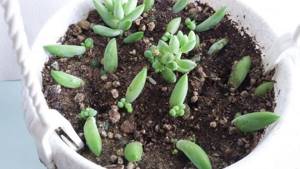
Individual leaves can simply be stuck into the ground, and soon a full-fledged plant will appear
Important! You cannot take cuttings during flowering, or use a plant that is less than 3 years old.
Reproduction by dividing bushes
In the fall, and if necessary in the spring, the plant is dug up and then divided into parts. Live buds are left in each. Afterwards, new sedums are planted in soil, preferably sandy.
Before planting succulents in pots, drainage is made from pebbles; you can use brick or expanded clay.
Reproduction of sedum
In early autumn, a soil mixture of sand and garden soil is poured into the planting boxes, leveled and slightly compacted. Sedum seeds are distributed over the surface, covered with sand and moistened. Boxes with plantings are installed in the greenhouse for germination.
If you sow sedum seeds in the spring, then stratification will be a mandatory procedure. To do this, boxes with plantings are covered with transparent film or glass and placed for 14 days in a place where the temperature is 0-5°C. During this time, regular ventilation and light watering are required to ensure that the soil is always moist.
When several leaves appear, young sedum seedlings dive into separate pots and, after rooting, are transplanted into open ground.
Flowering of sedums grown from seeds occurs in the 2-4th year. However, in this case, new plants can differ from their maternal roots, thus producing interesting new species.
In the case when you need varietal sedum, propagation is best done vegetatively, namely by dividing the bush or cutting shoots. Sedums are easily propagated by cuttings, which in most cases take root without any special shelter. This is the simplest and most common method; Seed propagation is more labor-intensive and is used more often in breeding work.
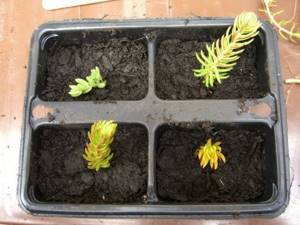
Caring for sedums in the garden
Sedum is an unpretentious plant, but it needs to be weeded often, and the soil at the roots is loosened. Water only in hot weather, when there has been no rain for a long time.
Cultivated species are fed in autumn and spring. Use chicken manure (1:20 solution) or mullein infusion (1 part infusion to 10 parts water). For mulching, use tree bark and small stones.
Note! Every 5 years it is advisable to replant the bushes or rejuvenate them by removing old parts.
In winter, plants are pruned, heat-loving sedums are covered with straw, wood shavings, and spruce branches.
Problems during cultivation
Sedums are hardy, but in poor conditions they die and get sick. Pests are especially dangerous:
- thrips;
- sawflies;
- common aphid;
- any caterpillars;
- nematodes.
Fungal infections are dangerous for milkweed. The only salvation from them is to trim the leaves on which dark spots have appeared.
In case of improper care, note:
- root rotting;
- drying of leaves;
- lethargy of shoots;
- stretching the plant to height.
Sedum prominent (video)
Today, these varieties are the most popular in the European region. We recommend that readers of our site take a closer look at this wonderful plant and choose exactly the species that will soon appear on your site.
Using sedums in landscape design
Sedums are indispensable for creating lawns, alpine slides, decorating borders, paths and vertical surfaces.
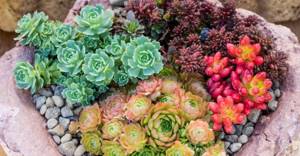
The variety of sedums allows you to create real living canvases from them
One of the main properties of sedum is that it is effective at any time of the year, so it is used in gardens where other plants lose their beauty in the fall. Especially popular are purple, yellow, and bluish sedums. By combining them, they create amazingly beautiful combinations.

